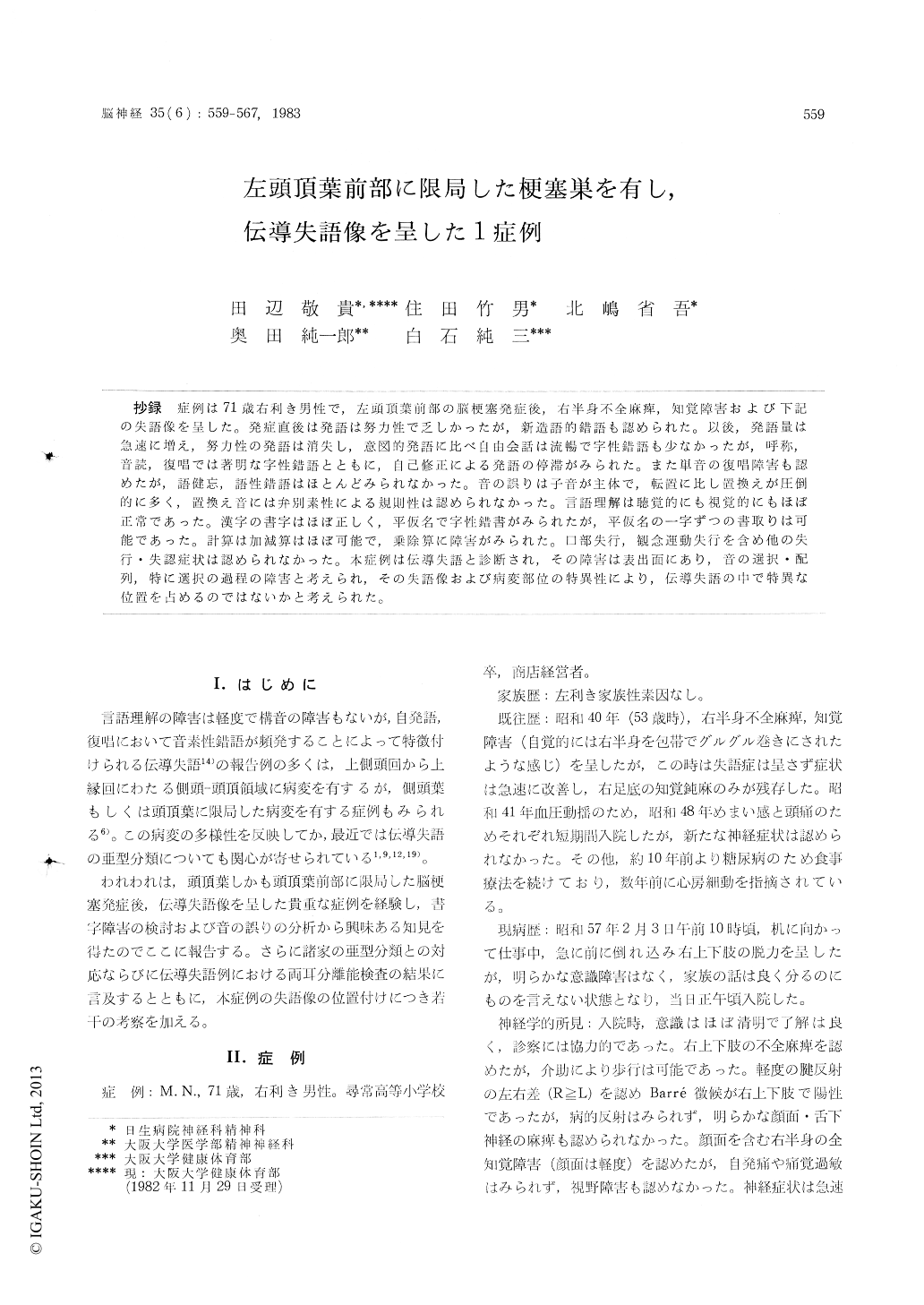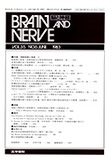Japanese
English
- 有料閲覧
- Abstract 文献概要
- 1ページ目 Look Inside
抄録 症例は71歳右利き男性で,左頭頂葉前部の脳梗塞発症後,右半身不全麻痺,知覚障害および下記の失語像を呈した。発症直後は発語は努力性で乏しかったが,新造語的錯語も認められた。以後,発語量は急速に増え,努力性の発語は消失し,意図的発語に比べ自由会話は流暢で字性錯語も少なかったが,呼称,音読,復唱では著明な字性錯語とともに,自己修正による発語の停滞がみられた。また単音の復唱障害も認めたが,語健忘,語性錯語はほとんどみられなかった。音の誤りは子音が主体で,転置に比し置換えが圧倒的に多く,置換え音には弁別素性による規則性は認められなかった。言語理解は聴覚的にも視覚的にもほぼ正常であった。漢字の書字はほぼ正しく,平仮名で字性錯書がみられたが,平仮名の一字ずつの書取りは可能であった。計算は加減算はほぼ可能で,乗除算に障害がみられた。口部失行,観念運動失行を含め他の失行・失認症状は認められなかった。本症例は伝導失語と診断され,その障害は表出面にあり,音の選択・配列,特に選択の過程の障害と考えられ,その失語像および病変部位の特異性により,伝導失語の中で特異な位置を占めるのではないかと考えられた。
The patient is a 71-year-old right handed man. He suffered cerebral infarction which produced aphasia, right-sided weakness and sensory deficits in all modalities. But he did not developed any signs of thalamic and pseudothalamic syndromes. The neurological signs improved remarkably over the ensuing weeks. As the neuropsychological signs except aphasia, there was no evidence of agnosic and apraxic signs including auditory ex-tinction on both nonverbal and verbal stimuli, oral apraxia and ideomotor apraxia. It is note-worthy that ideomotor apraxia was not associated in spite of the presence of the parietal lesion.
Aphasic symptoms were as follows. Right afterthe stroke, his speech was sparse and effortful with a little articuratory distortions and neologi-stic paraphasias. Afterwards, the number of utte-rances increased rapidly and his free conversation became fluent and meaningful although sometimes contaminated with some phonemic paraphasias and hesitations. However, the impairments in naming things, oral reading and repetition were quite evident with frequent blockings and phone-mic paraphasias. He ofren tried self-correction, but errors made were not usually corrected, even with repeated efforts. His efforts frequently resul-ted in slow and careful pronunciations of sylla-bles in a word. His articulation itself was excel-lent. Anomia and semantic paraphasia were hardly recognized. In contrast to these profound impair-ments in speech outputs, his aural and reading comprehension were almost normal even for com-plex materials such as the Token Test from the incipient stage of the stroke. As for the distur-bance of repetition, the difficulty increased propor-tionately to the increase in the number of sylla-bles in a certain given word. Besides, the repeti-tion of nonsense syllables was more difficult than that of a word and he made mistakes even in a one syllabic repetition task. Writing was also disturbed. Namely, he could write Kanji (ideog-ram) almost correctly, but showed many literal paragraphias in writing Hiragana (phonogram) on both spontaneous writing and dictation. However, he could write everything in Hiragana when di-ctated singularly letter for letter. In calculation, addition and subtraction were possible althoughhe took some time, but multiplication and division were disturbed severely. From these clinical pictu-res, his aphasic type was diagnosed as conduction aphasia. In addition to the above-mentioned clini-cal features, a neurolinguistic analysis manifested interesting results. That is, both in the naming tasks and in the repetition tasks, speech sound errors mainly occurred in consonants, and concern-ing the kinds of consonant errors, substitution was more than transposition and accounted for the large part of them. These results were in ac-cord with the characteristics of Broca's aphasia. On the other hand, in an analysis of consonant substitution errors by the distinctive feature fra-mework, errors were distributed almost at random in terms of the feature distance in the naming tasks, while the frequency of one- and two-feature errors increased somewhat in the repetition tasks. And then, this result correspond to the characte-ristic of conduction aphasia.
To sum it up, his language disturbance is pri-marily an impairment of speech output in all varieties that is marked most heavily with literal paraphasias and literal paragraphias. In addition, the clinical features and neurolinguistic characteri-stics suggest that the expressive difficulty is in the process of selection and arrangement of pho-nemes, especially the former. In conduction apha-sics, this case may be located in a particular position by the clinical features including the neurolinguistic characteristics and by the site of the lesion in the anterior parietal region.

Copyright © 1983, Igaku-Shoin Ltd. All rights reserved.


